"Fiscal Policy and Income Inequality," by David Lipton, First Deputy Managing Director, IMF, Washington, D.C., March 13, 2014
March 13, 2014
First Deputy Managing Director, IMF
At The Peterson Institute for International Economics
Washington, D.C., March 13, 2014
As prepared for delivery
Thank you for providing me the opportunity to present the key findings of a new IMF study on fiscal policy and income inequality.
Income inequality has been rising in many parts of the world in recent decades. This, and the social tensions associated with fiscal consolidation that many have faced in part stemming from the global financial crisis, have put the distributional impact of governments’ tax and spending policies at the heart of the public debate in many countries. Of course, the question of just how much redistribution the state should do is, at its core, a political one that economic analysis cannot answer. But I think that we can all agree that whatever degree of redistribution governments choose, it should be done with fiscal instruments that achieve their distributional objectives at a minimum cost to economic efficiency.
The design of these growth-friendly, efficient redistributive fiscal policies is the focus of my presentation today.
Some may be surprised that the Fund is engaging in this debate on the design of redistributive policies. The truth of the matter is that we have been at this for a long time. Assessing the effect of tax and expenditure policies on efficiency, and any potential tradeoffs with distributional goals, has long been an important component of the IMF’s policy advice. Furthermore, the design of Fund-supported programs is inevitably influenced by the authorities’ distributional objectives. Whenever we discuss social safety net programs, or the level of health and education expenditures, and how to generate the revenues or finance to sustain them, subjects we routinely address, we are discussing redistribution policy.
Our record for protecting the poor in the design of Fund-supported programs has a longstanding history, going back to the Camdessus era in the 1980s.
So, this paper should thus be seen as the Fund’s advice to its membership, based on our extensive experience. Of course, one reason why we are discussing this issue today is that the interest in redistribution as reflected in public surveys and our discussions with our members is higher than in the past. Our members want to explore with us how they can pursue distributive policies in an efficient manner.
The key message that I want to convey today is that when it comes to fiscal redistribution, design matters. This is consistent with a recent IMF staff study by Ostry et al, which finds that, on average, inequality is associated with lower growth. Thus fiscal redistribution can help support growth because it reduces inequality. What we see is a diversity of experience across countries with redistributive policies. Some redistributive fiscal policies can help improve efficiency and support growth, such as those that enhance the human capital of low-income households. Let me be clear, redistributive policies can generate a tradeoff between equality and efficiency, and if misconceived, this tradeoff can be very costly. I will cite examples of this problem later on. But as I said, design matters, and smart design can help to minimize the adverse effects of redistributive policies on incentives to work, save, and invest.
My presentation today will cover three broad topics, including trends in inequality, the experience of countries in using redistributive policy, and options for achieving more efficient redistribution.
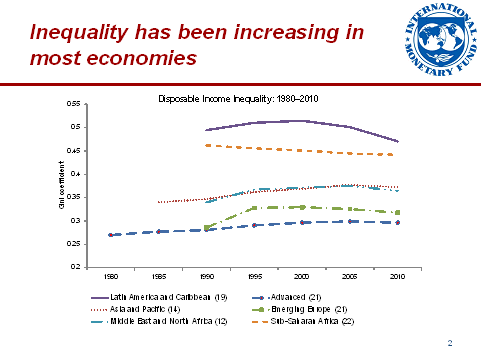
Let us first move to the discussion of trends in inequality. This figure presents the trends in the average Gini coefficient for disposable income. Gini coefficient ranges from 0 to 1, with larger values representing higher inequality. Disposable income is market income after income and wealth taxes and cash transfers. Over the last three decades, the Gini coefficient has increased in most countries, indicating an increase in inequality. In Latin America and sub-Saharan Africa, however, there has been a declining level of inequality more recently. What is most striking in the figure, however, are the persistent differences across regions, with Latin America having the highest inequality and the advanced economies having the lowest.
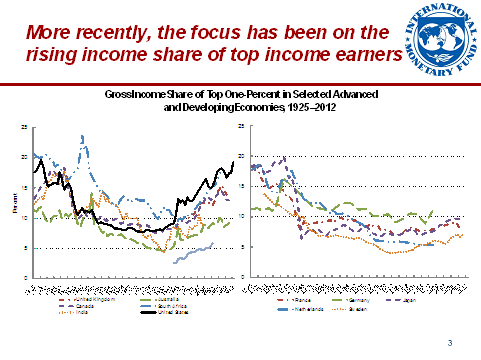
More recently, there has been great attention to the rising share of top income earners. The trends across countries appear mixed. In some economies, such as the United States and South Africa, the share of the top one-percent has increased dramatically in recent decades, but not so in continental Europe and Japan, where it has been largely unchanged. There are differing views of the causes of the rising share of the top one percent. Some emphasize the impact of globalization and new technologies, while others highlight policy choices, such as reductions in tax rates, and others the rent-seeking behavior of executives.
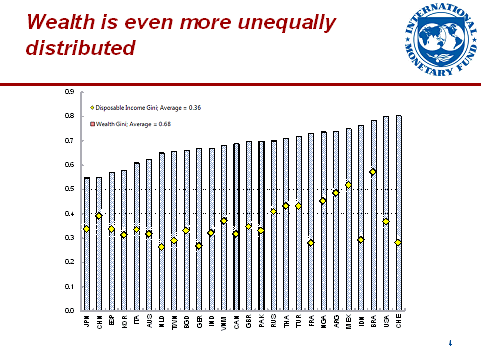
If we compare the distribution of income with that of wealth, we can see that wealth is much more unequally distributed, as indicated by the higher Gini coefficients. In a similar vein, a recent Oxfam study found that that the richest 85 people in the world own the same amount of wealth as the bottom half of the world’s population. Both the high degree of inequality of wealth, and the increased share of the top one percent, have fueled the recent debate on income and wealth taxation.
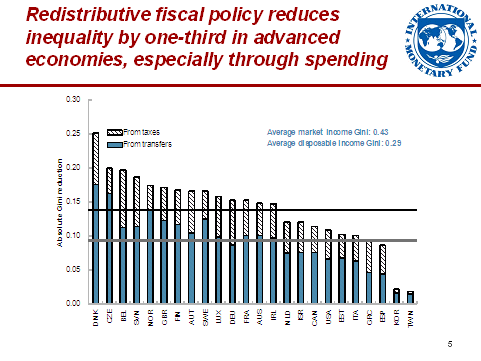
Let us now turn to country experience with different instruments for fiscal redistribution. We will start with the advanced economies, where countries are already doing a substantial amount of redistribution. The average market income Gini, i.e., in the absence of any fiscal redistribution, is 0.43. Redistributive transfers and taxes reduce inequality by about a third, with about two-thirds of this coming from transfers.
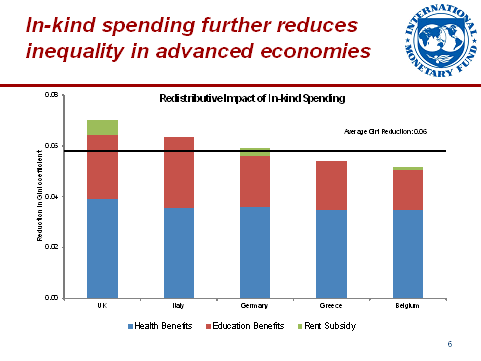
The previous slide does not include the impact of in-kind benefits, such as public spending on health, education, and housing. In the countries selected here, it is estimated that in-kind transfers further reduce the market Gini, on average, by more than 10 percent. Thus, we can conclude that based on both direct and in-kind benefits, fiscal policy has played a major role in reducing inequality in advanced economies, although its extent varies across countries.
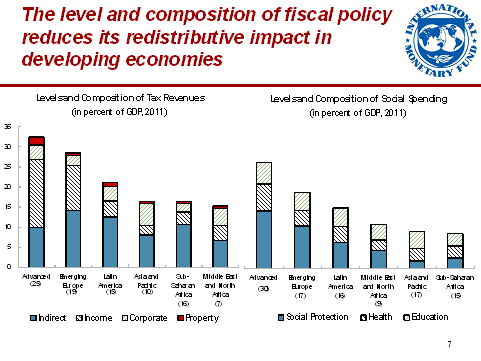
So what about developing economies? Developing economies here include both emerging and low-income countries. It appears that fiscal policy has played a much more modest role there. Let’s first look at the tax side. The levels of tax revenues are significantly lower in developing economies, with the exception of emerging Europe. In terms of composition, indirect taxes, like the VAT, account for a much larger share, which tend to be less progressive than direct taxes such as the income tax. On the expenditure side, again, levels of redistributive expenditures are much lower, particularly when it comes to social protection.
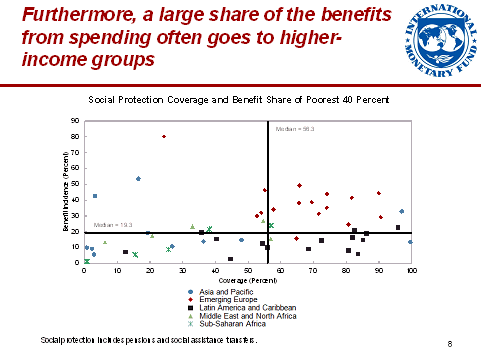
A lot of the social spending in developing economies is not well designed and targeted and actually increases inequality. With the exception of emerging Europe, the poorest 40 percent of the population receive less than 20 percent of the benefits of social protection spending. The coverage of social benefits, in terms of the percentage of poor households that receive benefits, is also low, except in emerging Europe and Latin America.
In this context, it is also important to note that many developing countries use energy subsidies as a form of social assistance. But as we underscored in the work we presented at the Peterson Institute last year, these subsidies disproportionately benefit upper-income groups.
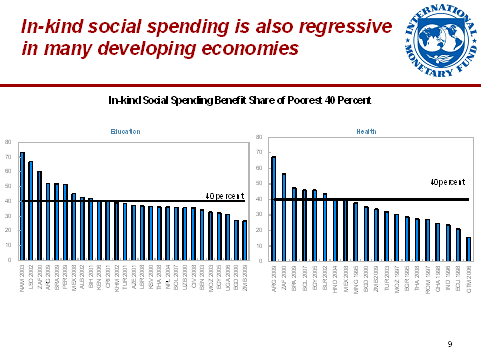
Education and health spending in developing economies is also not well targeted and exacerbates inequality. In many developing economies, for example, the poorest 40 percent receive less than 40 percent of the total benefits, which contributes to inequality of opportunity and low intergenerational mobility. One reason for this is that the poor often lack access to these services, reflecting the fact that many of them live in poor rural areas while services are concentrated in urban areas.
This discussion of the redistributive effect of fiscal policy in advanced and developing economies has important implications for the design of fiscal consolidation packages. As shown in our paper, a number of economies have adopted progressive adjustment measures during their recent fiscal consolidations. As a result, the burden of these adjustment measures on the bottom 20 percent of the population was lower than that of upper income groups. For example, in Greece, Latvia, Portugal, Romania, and Spain, cuts in public sector pay had a smaller effect on civil servants toward the bottom of the pay-scale. In Spain and the United Kingdom, increases in income taxation were born more heavily by upper-income groups.
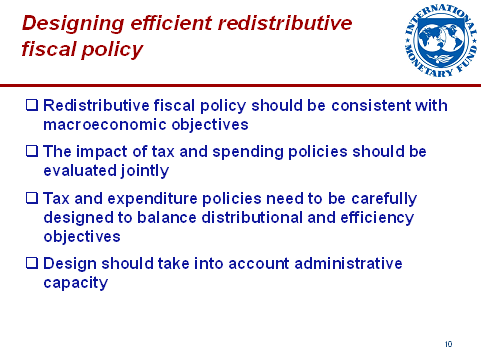
Let us now turn to options for designing fiscal redistribution in an efficient manner. We see four key considerations in designing efficient redistributive fiscal policy:
First, redistributive fiscal policy should be consistent with macroeconomic policy objectives. The level of spending on redistribution, for example, should be consistent with macroeconomic stability. In addition, the benefits of additional spending on redistribution should be compared with the benefits of raising spending in other priority areas, such as infrastructure.
Second, taxes and expenditures should be evaluated jointly. For example, an increase in VAT revenues, used to finance higher spending in secondary education, could—on net—be progressive.
Third, the design of redistribution policies should account for both redistributive and efficiency objectives. Some redistributive policies may in fact enhance efficiency, such as those that strengthen human capital. But with others there may be the need to manage a tradeoff.
And fourth, design should take into account administrative capacity.
Based on these principles, we examine a range of options for achieving redistribution efficiently. The paper provides an extensive discussion of instruments. In the interest of time, I will focus on a few of the most important options discussed in the paper. These measures could be implemented as part of long-term fiscal reforms aimed at achieving redistributive objectives more efficiently. They could also be integrated into the design of fiscal consolidation strategies that aim to help governments achieve redistributive goals at a lower fiscal cost.
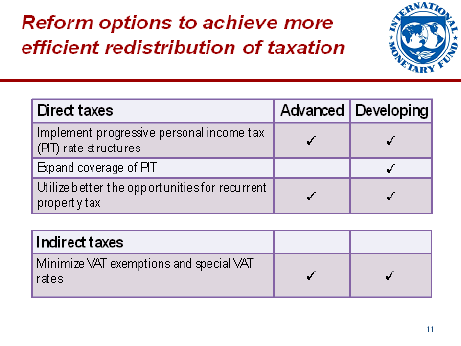
The primary contribution of taxation to reducing income inequality is through its financing of redistributive spending measures in a way that it does not harm growth. Nevertheless, taxes can also have a direct effect on redistribution. This is particularly the case for income taxes.
To start, countries could consider making their income tax systems more progressive. For example, in economies where a flat rate is used, there may be scope for more tax progression at the top. Since the mid 1990s, 27 countries—especially in Central and Eastern Europe and Central Asia—have introduced flat tax systems, usually with a low marginal rate. The top personal income tax rate must, however, be set with care. If it is too high, taxpayers will find ways to avoid or evade the tax and a higher rate may no longer raise extra revenue. In many developing economies, both fairness and equity could be enhanced by bringing more informal operators into the personal income tax.
There is also scope to more fully utilize property taxes, both as a source of revenue and as an efficient redistributive instrument. This applies also to developing economies, where only Colombia, Namibia, Russia, South Africa, and Uruguay collect more than 1 percent of GDP through recurrent property taxes.
Indirect taxes, including the VAT, are generally less effective in achieving redistributive goals than direct taxes. On the VAT, the recommendation is thus to minimize exemptions and special rates, in order to efficiently raise revenues to help finance pro-poor spending. For instance, elimination of reduced VAT rates in the United Kingdom, and using the proceeds to increase social benefits, would significantly reduce inequality. Earlier work at the IMF has shown that in Ethiopia, the net impact of a uniform VAT, with the proceeds used for general spending on education and health, would have a strong progressive impact. However, where capacity constraints prevent spending programs from reaching the poor, there can be a case for some differentiation in VAT rates, for example for basic foods that are a large part of the spending of the poor.
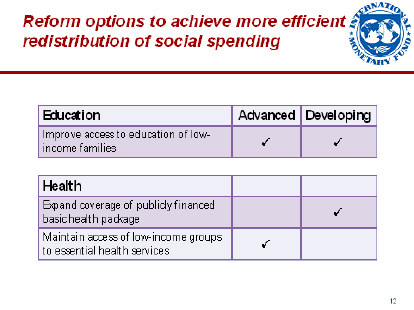
On the expenditure side, I would like to start first with education. Improving the access of low-income families to education is an efficient tool for boosting equality of opportunity, and over the long run, it can also reduce income inequality. In advanced economies, this entails increasing the access to tertiary education for low-income families, including through scholarships and loans. For developing economies, a strengthening of access to quality secondary education is also required, for example, by eliminating tuition fees.
Along the same lines, improving the access of the poor to health care services in developing economies can provide a head start to greater opportunity and do so in an efficient manner. Some countries, including China, Ghana, India, and Mexico, have taken important steps toward universal coverage in recent years. In advanced economies, maintaining the access of the poor to health services during periods of expenditure constraint is also consistent with efficient redistribution.
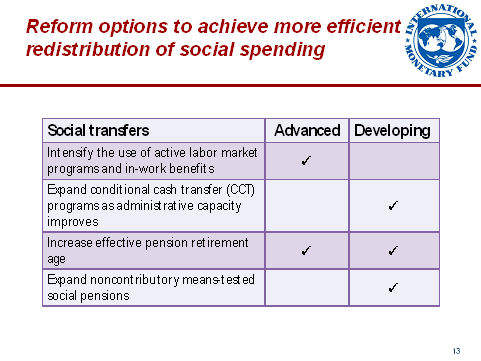
To make social transfers more efficient in advanced economies, there could be greater use of active labor market programs and in-work benefits for social benefit recipients. This would, for example, require beneficiaries to participate in active labor market programs, such as job training, as a condition for receiving benefits, as done in Belgium, the Slovak Republic, and Slovenia.
The second reform measure that I will focus on is to expand conditional cash transfer programs in developing economies. These programs make benefits conditional on the attendance of children at health clinics and at school. Means-testing helps keep the fiscal cost low. This policy can help boost both equality of opportunity and income inequality. For instance, the direct impact of such transfers in Brazil and Mexico accounts for one-fifth of the reduction in inequality between 1995 and 2004 in these two countries. A strengthening of administrative capacity, however, is required for implementing these programs in many developing economies.
Pensions have played an important role in reducing income inequality. To improve the sustainability of pension systems and maintain their role in protecting the elderly poor, many economies could consider increasing effective retirement ages. This would need to be accompanied by measures to ensure that lower-income workers are fully protected, as needed, with disability pensions and social assistance if they are unable to work. In developing economies, to ensure wider coverage of pensions at a reasonable fiscal cost, a viable option is to expand noncontributory, means-tested social pensions. Social pensions in some form exist in both emerging and low-income developing countries, including in Chile, Ethiopia, India, and South Africa.
Many countries have been grappling with the twin challenge of putting their pension systems on sound financial footing while safeguarding or expanding their important role in alleviating old-age poverty. I would like to take this opportunity to bring your attention to a new IMF book, “Equitable and Sustainable Pensions: Challenges and Experience,” which we are also launching today. The book examines the complex equity issues involved in designing pension systems, including generational and gender equity. It also presents 12 country cases studies to help draw lessons for designing sustainable and equitable pension systems.
Let me end where I started. Many advanced and developing economies are facing the challenge of rising inequality. Fiscal policy has played a major role in reducing inequality in the past and is the primary tool available for governments to affect income distribution. Whether these policies help, or hurt growth, is all a matter of design. And the details matter. Thus, debates on the impact of the government’s redistributive policies must go far beyond a mere discussion of tax and spending ratios. In the end, it is design that matters. And on this, the good news is that quite a lot is now known about how governments can best address the challenges of squaring their equity and efficiency concerns, a task on which the Fund stands ready to help.
Thank you.
IMF COMMUNICATIONS DEPARTMENT
| Public Affairs | Media Relations | |||
|---|---|---|---|---|
| E-mail: | publicaffairs@imf.org | E-mail: | media@imf.org | |
| Fax: | 202-623-6220 | Phone: | 202-623-7100 | |


